According to a 2018 report by the Australian Institute of Health and Welfare, there have been over 1,000 people that were brought to the hospital due to electrical injury in 2014-15, 47% of which was electrocuted while doing paid work. Although electricity-related injuries have fortunately become less frequent over the years, it still shows that there’s a risk when working with electricity. However, independent electricians and those working for electrical contractors are exposed to more than just electrical hazards. As such, we’ll be taking a look at safety tips every electrician should know about:
Protective Personal Equipment and Safety Clothing
Different jobs require different types of protection, but generally, when working with electricity, you should be covered and protected from head to toe. A hard hat and safety goggles would prevent any possible injuries to your eyes and head, while a mouth mask would prevent you from breathing in dust, solder smoke, and other harmful gases.
Additionally, you shouldn’t just wear any hard hat, but preferably a Class E (electrical) hard hat designed for electrical work and can withstand up to 20,000 Volts. A safety vest is essential in having other workers see you. Safety gloves with good thermal and electric insulation is a must for almost all types of jobs. Cuts and fire hazards are also a constant risk, which is why it’s recommended to wear fire-retardant coveralls to protect every inch of your skin from getting cut or burned. Lastly, you’ll need industrial safety footwear to protect your feet from impact as well as punctures.
Use Appropriate Equipment and Materials
One of the best ways to keep yourself safe is by remembering your training and use the right equipment and materials for the job. You should always use insulated tools when working with electric components, even if you have insulated gloves on. Additionally, using the right material for the job would ensure both your safety and the safety of your work, for example, if you’re going to mount electrical fixtures on a hollow and porous/brittle material, you should use good quality nylon anchor fasteners as nylon has good thermal and electrical insulation.
Inspect and Maintain Your Tools
Speaking of the tools, you’ll be using; it’s just as important that you always check and maintain your tools to ensure that they’re in working order. For example, using dull drill bits increases the risk of breathing in silica dust while sharp drill bits minimise the dust produced when drilling. Also, electricians constantly work with ladders, make sure that you have a well-maintained and locked correctly in before using.
Never Touch Anyone Who’s Electrocuted
When you’re working with other electricians, and someone gets electrocuted, it’s important to prevent your initial impulse of wanting to reach out and pull them back. You have to remember that the human body is a conductor and you’d be electrocuted upon contact. Remember your safety training: make sure to turn off the primary power source, call emergency services, and begin CPR while waiting for the ambulance. If you’re unable to turn off the power source, use any item made of wood or plastic to push them away from the electricity source.
Keep Your Workspace Clean
This applies to almost any type of work as well, but more so for those working in construction and the electrical industry. Clutter around your work area could be potential fire, tripping, slipping, or puncture hazards. So make sure that you clean up before and after working on the electrical fixtures and systems.
Conclusion

An electrician’s job is a risky one if you don’t take the proper safety precautions, so remember your safety training or at least these very basic safety tips to minimise the risk of occupational hazards.

